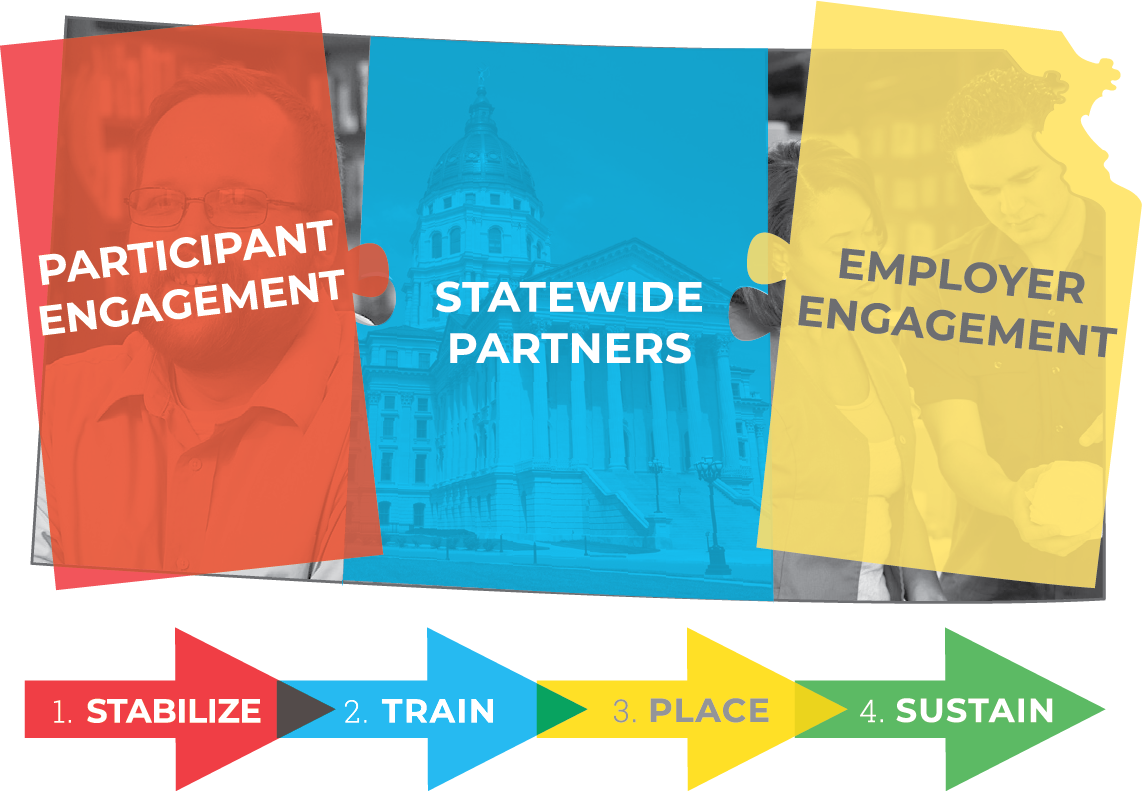Program Model

Model Phases
The GOALS service model individualized services with a career navigator providing guidance and support through four service phases: Stabilize, Train, Place, and Sustain. Intensive, strengths-based case management was at the core of services.
1. STABILIZE: Intensive Case Management Services
Objective: Participants demonstrate appropriate competencies and skills to prepare them for job training, placement, and retention.
Description: During this phase, and throughout the pilot, career navigators were the primary point of contact for each participant, in some cases working closely as a team with community partners in mental health and substance use disorder, and/or training agencies to help participants with stabilization.
Staff working with the treatment group received ongoing, in-depth training on strengths-based case management, motivational interviewing techniques, trauma-informed care and Adverse Childhood Experiences (ACEs), financial literacy, and cultural competency.
Stabilize features:
- Intensive case management
- Individualized assessments
- Employment preparation and planning
- Assistance with relocation as needed
- Emergency employment as needed, to secure housing and transportation
- Support services
- Substance use disorder treatment services as needed
- Mental health assessment and services as needed
2. TRAIN: Job-driven Training and Career Pathways
Objectives: Participants receive, or are progressing toward, post-secondary education for in-demand jobs. Participants have the opportunity for placement in positions after they complete training.
Description: GOALS provided a unique opportunity to help participants navigate the complexity of accessing training and education. It also brought together community colleges, employers, and community-based organizations. Through these partnerships, GOALS encouraged flexibility and, where appropriate, reductions in the timeframe necessary for certificate and degree program completion to better align with labor market realities.
Train features:
- Build employer partnerships
- Match participant skills to labor market
- Assist navigating post-secondary education system
- Develop short-term skills training for in-demand jobs
- Encourage employer participation in orientations and trainings
- Provide ongoing training for career advancement
- Support self-examination and personal growth through programming
3. PLACE: Work-based Learning
Objective: Participants are employed in settings that support ongoing training and career advancement.
Description: Employer liaisons played an important part during the Place phase. Their role was to identify employers with openings on an ongoing basis, provide the flexibility needed to respond to emerging employer needs, and assist with finding emergency employment for participants in order to secure their housing and transportation. The employer liaisons also found employers willing to help lead the job preparation and life-skills classes, and to assist with mock interviews and workplace tours. Staff connected with employers and participants for 90 days after placement to make sure the employee was a good fit, work out logistics, and moderate difficulties.
Place features:
- Match participants to local labor market demands
- Support ongoing training and career advancement
- Build employer/participant partnerships
- Assist participants to obtain gainful employment
- Host hiring events
- Educate employers
4. SUSTAIN: Job Retention
Objectives: Participants demonstrate satisfactory job performance within their first 90 days of employment. Employers report satisfaction with participants’ performance within the first 90 days of employment.
Description: GOALS introduced a critical new component to the state’s existing employment and training model: 90 days of job retention support and an employer liaison in each region to support both the employer and employee. The pilot provided an opportunity to demonstrate the importance of continued transition support during the first 90 days for participants who may have been unemployed or underemployed for a long period. This highly proactive approach involved soliciting ongoing feedback from the employer and the participant, one-on-one coaching with the career navigator, and regular opportunities for support through peer groups established during the Train and Stabilize phases. The continuity of these ongoing relationships, coupled with the ability to share experiences with peers, provided participants with a supportive framework to navigate challenges such as loss of child care or transportation assistance, and difficulty adjusting to workplace norms.
Sustain features:
- Participant feedback
- Employer feedback and education
- Peer coaching and mentoring
- Transition services
- 90-days post-hire support for employees and employers
Evaluation
As a part of a national study, Kansas participated in a rigorous, longitudinal evaluation conducted by Mathematica and MDRC and funded by the Agricultural Act of 2014.
The national pilot outcome data will be compiled and analyzed by the USDA’s contracted evaluation team led by Mathematica Policy Research and its partners. The findings will be presented to the United States Congress. Each report will discuss four study components: implementation, impact, participation, and cost-benefit analyses.
The findings from the evaluation will be posted on the FNS website. USDA posted the first report to Congress in June 2016. This report provided the status of the projects through the end of FY 2015. USDA anticipates the mid-term report will be available in 2019 and the final report in 2021.


Funding provided by the United States Department of Agriculture (USDA). The GOALS program is administered through the Kansas Department for Children and Families (DCF). The USDA and DCF are equal opportunity employers and providers.
